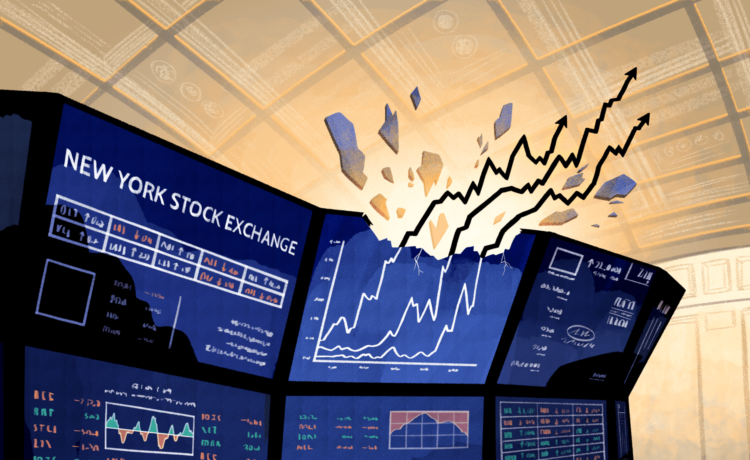Key Takeaways
- The S&P 500 rose nearly 4% in the second quarter, boosted by surging semiconductor stocks and tech mega-caps even as the majority of the index declined.
- The AI theme extended beyond tech. Utilities and green-energy stocks soared as Wall Street considered the AI revolution’s gargantuan electricity needs.
- Narrow market breadth, overextended chip stocks, and the S&P 500’s concentration in tech are a few of the developments that have analysts concerned heading into the second half.
The stock market just wrapped up a strong second quarter powered by big tech stocks. That’s making some analysts nervous.
The market-cap weighted S&P 500 gained 3.9% over the quarter, closing at a record high nine times. Yet the equal-weight index fell 3.1% from an all-time high at the end of the first quarter.
The discrepancy can largely be chalked up to one theme: artificial intelligence. That was the driving force behind Nvidia’s (NVDA) 36% gain in the quarter, as well as Apple’s (AAPL) rebound from its first-quarter slump. The tech titans, which head into the second half with market capitalizations above $3 trillion, have helped make a tepid market appear red hot.
AI Lifts Chip Stocks—But Not Only Chip Stocks
Just three of the benchmark S&P 500’s 11 sectors outperformed or matched the broader index in the second quarter: Information Technology (up 13.6%), Communication Services (up 9.1%), and Utilities (up 3.9%). About 25% of S&P 500 stocks outperformed the index itself.
Within tech, there was a stark difference between the quarter’s winners and losers: Of the industries that make up the sector, only semiconductors outperformed the S&P 500.
Nvidia shares continued to surge, briefly making it the world’s most valuable company. Chipmaker Broadcom (AVGO) soared as the ongoing build-out of AI infrastructure boosted its quarterly sales, while Qualcomm (QCOM) advanced after unveiling a new on-device AI processor.
But software shed 3% over the quarter, while the internet services and infrastructure industry dropped almost 7%. Software giant Salesforce (CRM) slumped in early June on soft sales and weak guidance. Smaller software names like Shopify (SHOP), Workday (WDAY), and MongoDB (MDB) tumbled on similarly disappointing results.
Oracle (ORCL) saw its stock jump not because of brilliant earnings—it missed on revenue and profit—but because it announced a cloud partnership with Microsoft (MSFT) and OpenAI.
Investors’ appetite for artificial intelligence plays was so great that they looked beyond chipmakers in search of the AI revolution’s pick-and-shovel sellers. The S&P 500’s second-best performing stock after Nvidia was First Solar (FSLR), which got a boost early in May when analysts dubbed it a potential AI beneficiary.
Utilities, typically a quiet corner of the market favored by income-focused investors, continued to perform like a high-growth sector. Vistra (VST), which joined the S&P 500 in May after its shares surged 80% in the first quarter, was among the index’s top stocks. NRG Energy (NRG) and NextEra Energy (NEE) each advanced more than 10%.
Some Analysts See Trouble Under the Hood
Outside of those pockets of the market, however, the second quarter was quite a bit rougher.
The energy, financial, health care, industrial, materials, and real estate sectors have all declined since March. About 60% of the S&P 500 finished the quarter in the red.
The divergence between the S&P 500 and the majority of its components was on full display in June. As Nvidia and other chip stocks soared, the S&P 500 hit record after record. And yet the S&P 500’s advance-decline line, a representation of the share of stocks rising and falling, began to slide, a sign of trouble under the hood.
On June 12, when the S&P 500 notched its fifth record close of the quarter, “only 34% of S&P 500 stocks closed above their short-term 20-day moving average…marking the lowest percentage to accompany a new high since data began in 1990,” according to Adam Turnquist, Chief Technical Strategist at LPL Financial.
What’s Next for Stocks?
Some market watchers see more room for the bull market to run, especially if second-quarter earnings come in as expected. Only three sectors—consumer staples, industrials, and materials—are expected to report that earnings contracted in the second quarter. Seven are forecast to report earnings growth exceding 5%. Evidence that corporate profits are holding up could help broaden stock gains.
History is also on the market’s side. When first-half gains are 10% or higher, according to an LPL Financial note Thursday, the S&P 500 rises more than 80% of the team, posting average second-half gains of nearly 8%.
Still, narrowing breadth is just one of the warning signs that has analysts sounding alarms in recent weeks. The “lack of confirmation in the latest breakout does not imply that the bull market is over but does raise the risk of a pause or pullback unless this rally broadens out,” Turnquist said.
Analysts at Piper Sandler issued a similar assessment on Tuesday when they said a correction was “likely.” Analysts noted that momentum was waning near the end of the month while defensive stocks began to creep into the ranks of the market’s top performers.
They also pointed to the index’s extreme concentration in tech—Microsoft, Nvidia, and Apple were cumulatively worth four times the entire Russell 2000 index of small-cap stocks—and the overextension of semiconductor stocks as causes for concern.












